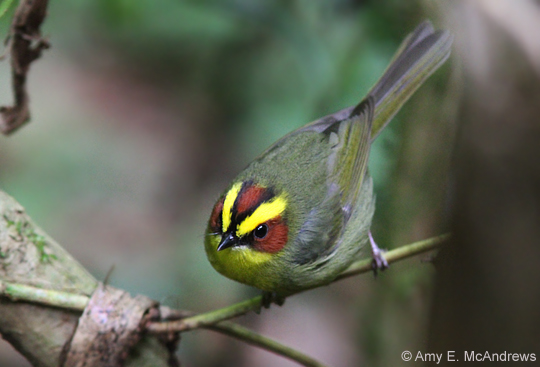Editors Note: This is the final post in a three-part series about migration through Veracruz, Mexico. View Part I: “North America’s Busiest Flyway,” or Part II, “A River of Raptors in Veracruz.” In addition to its abundance of migratory raptors and waterbirds, the state of Veracruz is rich with both migratory and resident passerine species. Learn more about them below.
Jacob Drucker worked for the Mexican non-profit Pronatura counting raptors and other soaring birds in the fall of 2017. He submitted this series based on his experiences in Veracruz.
Warblers and the majority of other neotropical migrants migrate at night, making it difficult to actually see them on their journeys. In contrast to the enumerated, visible river of raptors and waterbirds, little is known about the number of warblers aloft over Veracruz on any given night in spring or fall.
It is known, however, that warbler diversity in Veracruz is exceptional, with 52 migrant and resident species occurring in the state. This is due to the east-meets-west nature of Veracruz. While eastern species generally associate with the subtropical coastal plain and the Sierra Madre’s eastern slope, and western species with the temperate montane highlands, there is significant overlap around the mountain city of Xalapa. It is possible to observe Hermit, Townsend’s, Black-throated Green, and the endangered Golden-cheeked Warblers at a single location, occasionally on the same date!
These species comprise a sub-genus, with members that speciated in the wake of glacial cycles in North America. However, they all retain an affinity for conifer woodlands on their breeding and wintering grounds, and utilize these habitats heavily during migration as well.

Similarly, warblers with distinct eastern and western subspecies also converge in Veracruz, such as “Audubon’s” and “Myrtle” Warblers, and the Rocky Mountain and eastern subspecies of Wilson’s, Orange-crowned, and Nashville Warblers. This concept of converging eastern and western species extends far beyond warblers, with many species of flycatchers, vireos, and tanagers co-occurring on migration and in winter, regardless of their breeding areas in North America.
As with most migratory birds, neotropical migrants exhibit differential migratory routes during spring and fall, and this pattern shows strongly in Veracruz. In spring, when there is significant pressure for males to claim breeding territories, the pace of migration is fast and direct, with many birds jetting north up the coastal plain. In fall, the pace is more relaxed. Furthermore, prevailing winds in eastern North America take the majority of migrants through the Caribbean and eastern Gulf of Mexico, entering Central America via the Yucatan Peninsula instead of the Gulf’s western shores.
Nonetheless, large numbers of eastern and western species migrate through the Sierra Madre each fall, supplemented by several spectacular resident species endemic to Mexico’s highlands, such as Red, Golden-browed, and Crescent-chested Warblers and Hooded Yellowthroat. While Mexico’s endemic warblers do not migrate to the extent that their northern-breeding relatives do, many of them have local or even regional movements tied to seasonal variation in temperature and rainfall.
Whether it is migratory raptors, waterbirds, or passerines, visitors from the U. S. and Canada delight at seeing birds that are familiar from home, mixed in with stunning endemics.

Top photo: Hermit Warbler Frode Jacobsen © Creative Commons
